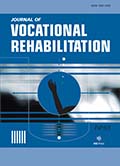Authors: Moore, Ruby | Friedman, Mark
Article Type:
Research Article
Abstract:
BACKGROUND: Recent laws, regulations, court cases and policies have included the requirement that people with disabilities be provided the opportunity to exercise informed choice in decision-making to promote inclusion and integration into society. These contemporary developments build on principles established in the early deinstitutionalization litigation, including rights to habilitation and to community settings as a remedy for unnecessary institutionalization. OBJECTIVE: This policy paper examines these regulatory, legal and policy changes to better understand the legal mandate for informed choice and its application to promote competitive integrated employment. METHODS: This policy paper analyzes the foundation of
…informed choice as presented in the Workforce Innovation and Opportunity Act (WIOA), the Home and Community Based Services (HCBS) Settings Final Rule, two landmark Department of Justice (DOJ) court cases (Oregon and Rhode Island) regarding sheltered workshops, the Olmstead decision by the Supreme Court and recent interpretations of the Americans with Disabilities Act. The paper includes interpretations of informed choice from key civil rights lawyers in key court cases, reviews of case law, statutes, regulations, policy initiatives, executive orders, state Employment First initiatives and landmark settlement agreements. RESULTS: It is the authors’ finding that, in combination, these laws, regulations and policies form a mandate for informed choice and create an affirmative obligation on the part of government entities to provide opportunities for people with disabilities to experience competitive integrated employment outside of sheltered workshops and other segregated settings as integral to making informed choices. CONCLUSIONS: The article posits that informed choice and the resulting affirmative obligation it embodies has not been sufficiently implemented by governmental and other private entities, and additional affirmative steps are needed to fully secure the legally mandated right to informed choice regarding employment services.
Show more
Keywords: Employment, self-determination, supported employment, competitive integrated employment, employment services, vocational rehabilitation, Olmstead, Pennhurst, informed choice
DOI: 10.3233/JVR-160860
Citation: Journal of Vocational Rehabilitation,
vol. 46, no. 2, pp. 245-264, 2017
Price: EUR 27.50





